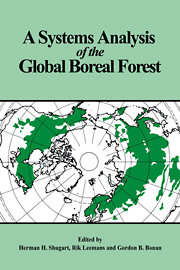Book contents
- Frontmatter
- Contents
- List of contributors
- 1 Introduction
- Part 1 Processes in boreal forests
- Part 2 Patterns in space and time in boreal forests
- Introduction
- 7 The transition between boreal forest and tundra
- 8 The southern boreal–northern hardwood forest border
- 9 Transitions between boreal forest and wetland
- 10 Remote sensing technology for forest ecosystem analysis
- 11 The nature and distribution of past, present and future boreal forests: lessons for a research and modeling agenda
- Part 3 Computer models for synthesis of pattern and process in the boreal forest
- References
- Index
8 - The southern boreal–northern hardwood forest border
Published online by Cambridge University Press: 12 January 2010
- Frontmatter
- Contents
- List of contributors
- 1 Introduction
- Part 1 Processes in boreal forests
- Part 2 Patterns in space and time in boreal forests
- Introduction
- 7 The transition between boreal forest and tundra
- 8 The southern boreal–northern hardwood forest border
- 9 Transitions between boreal forest and wetland
- 10 Remote sensing technology for forest ecosystem analysis
- 11 The nature and distribution of past, present and future boreal forests: lessons for a research and modeling agenda
- Part 3 Computer models for synthesis of pattern and process in the boreal forest
- References
- Index
Summary
Introduction
In this chapter we will examine the nature of the southern boreal forest, explicitly its transition with the cool temperate deciduous forest that occurs to its south. Although this mixed deciduous and conifer forest occurs on portions of several continents in the northern hemisphere, it is most intact and most studied in North America as the northern hardwood and conifer biome (Braun 1950; Curtis 1959). Therefore, although we will describe this zone in other regions, we will concentrate on the North American expression of it. For convenience, we will also adopt the shortened common name ‘northern hardwoods’ for the cool temperate and largely deciduous forest to the south while recognizing that certain conifers are also important components of this forest.
The southern boreal forest contains extreme contrasts in ecosystem properties corresponding to the locations of different species within a mosaic landscape. These properties are accentuated at its boundary with the northern hardwoods and conifers, which are transitional to the deciduous forests to the south. Within these two biomes, each genus, and in some cases different species within each genus, affects ecosystem properties in different ways. Such properties include nutrient cycling and productivity, disturbance type and frequency, and suitability as an animal habitat. Consequently, there are strong feedbacks between succession, species dominance, resource limitation, disturbance regimes, and trophic structure (Fig. 8.1). These feedbacks may be stabilizing or destabilizing, the latter often causing cycles at various times and in various places.
- Type
- Chapter
- Information
- A Systems Analysis of the Global Boreal Forest , pp. 216 - 240Publisher: Cambridge University PressPrint publication year: 1992
- 43
- Cited by



